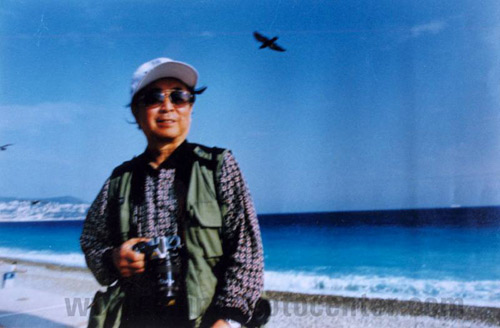At the age of 21, Lu Houmin was assigned to take pictures of the Chinese leaders in Zhongnanhai, including Chairman Mao Zedong. Later Lu became Mao's private photographer for 12 years.
"Today all I want to express is that I am really honored. The period that I worked with Mao was the golden time in my life," says 81-year-old Lu, who appears much younger and sharper than his age might suggest.
Titled "Mao Zedong In My Lens," the ongoing exhibition at the Shanghai Art Museum features about 100 of Lu's photographs of Mao.
|

|
|
Lu Houmin |
The photos record rare and personal scenes from the life of Chairman Mao, the great man who changed the history of China.
Some of the mystery surrounding Mao's personal life is revealed in Lu's photographs.
Viewers will be able to discover an ordinary loving father playing happily with his children and the leisure time that Mao enjoyed through swimming and table tennis.
"Many people ask me what was Mao's favorite picture," Lu says. "In fact, Mao didn't care about his pictures, but he was a very nice person and fully supported my job."
The erosion of time has not worn away Lu's first impression on meeting Mao.
"I was assigned to shoot some pictures of him at a meeting," he recalls. "What an honor for a young man at that time! My tender heart was filled with excitement and exhilaration."
But the overstated power that surrounded Mao gradually washed away for Lu. "Mao was an amiable person and he really cared about his staff - from his bodyguard and nurse to his doctor and cook," he says.
Lu recalls that in 1961 one of his pictures won an award, and he was invited to receive the honor in Cuba.
"You know, it was very difficult to arrange an overseas trip at that time," he says. "Unexpectedly Mao agreed to my trip, showing his strong trust in me."
Yet, life has its ups and downs.
Lu's special relationship with Mao also made him a target during the "cultural revolution" (1966-1976).
He was assigned to be "re-educated" in the countryside in Jiangsu Province with his family.
"I stayed there for seven years," he says, "but to tell the truth, I didn't feel tortured as I loved the peace and harmony of the countryside where one could be close to the nature."
Later one of his friends suggested that Lu write a letter to Mao to tell him of his situation.
"I wrote my first letter to Chairman Mao and the result was I got a new job in Jiangxi Province," he says with a smile. "Then I wrote a second letter to him, and finally I was able to return to Beijing."
Perhaps that's why Mao's death in 1976 shocked Lu.
"I still clearly remember the day when I heard of the death of Mao," he says. "I was sorrowful, much more sorrowful than the other people around me, as I had a special feeling and link with him."
When asked which characteristic of Mao he admires the most, Lu gives a simple reply: "You could not imagine how thrifty Mao was in life!"
The "icon of China" only had one pair of leather shoes and a well-patched blanket.
"Believe it or not, most of the delicacies we eat today had never been tasted by Mao. A great man! A great leader!" he says with a tremor in his voice. "He loved his daughters so much, yet the two girls could only dine at the canteen with all of us when they got home from school."
In fact, Mao was a great example in convincing his staff not to be "privileged."
"That's why even after his death, we didn't obtain many material benefits from him. I, together with some of his former staff, would reverently go to his memorial hall every September 9 and December 26 (the dates of Mao's death and birth)," he adds.
So does he still keep in contact with Mao's family? "We often meet at some memorial activities of Mao," Lu says.
There was a rumor in the photography community that Jiang Qing, Mao's third wife, once learned photography from Lu.
"No, that's not right. Of course, sometimes I also shot pictures of her," he says. But the pictures are not included in the exhibition.
"I bet you have read many of the memoirs written by the staff who had once worked for Mao," Lu says with a smile. "I don't want to repeat the same thing over and over in words. My pictures are actually more vivid and honest and show the public a real Chairman Mao."
(Shanghai Daily July 6, 2009)